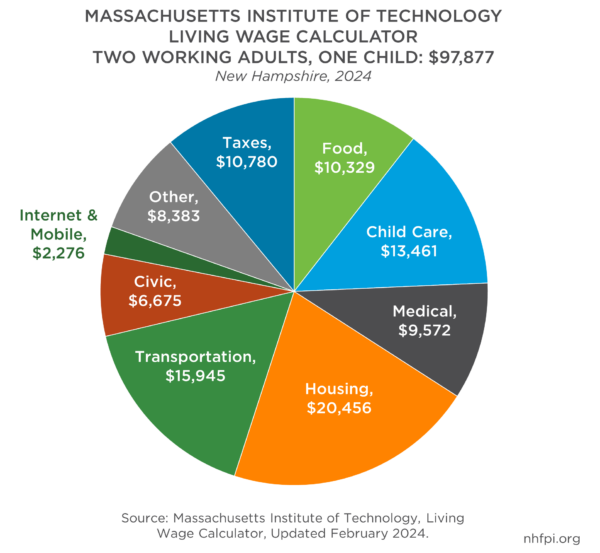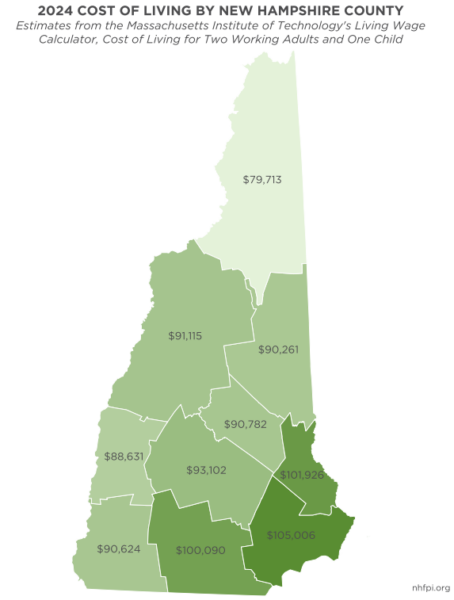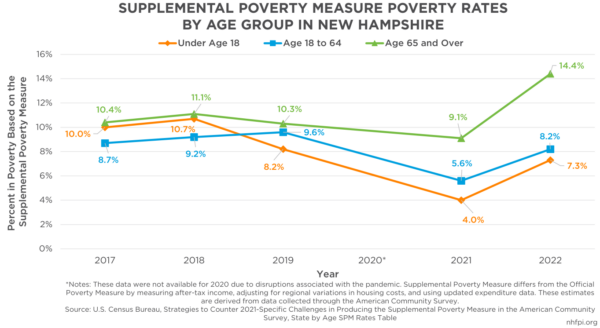This fact sheet provides a snapshot of financial hardships facing families in New Hampshire, including rising costs of living and varying rates of poverty.
Median Household Incomes by Family Type
- The estimated 2023 median household income in New Hampshire was approximately $96,838.[1]
- Between 2019 and 2023, the median income for a married-couple family with at least one child in New Hampshire was $152,054, while median incomes for single male householders with children and single female householders with children were $73,233 and $49,587, respectively.[2]

Living Costs Vary by Region and Family Composition
- On average, a Granite State family with one parent and one child would have needed $88,074 annually to have enough income for living expenses in 2024. A family with two working parents and one child needed $97,877.[3]
- Living costs vary by county: A family with two working parents and one child in Coos County needed $79,713 annually to afford living expenses in 2024, while the same family in Rockingham County needed $105,006.[4]
- Combined housing, health care, and child care prices make up a significant portion of Granite Staters’ household expenses. A family with two working parents and one child would need to spend about 44 percent of their household income on these three expenses combined.

Household Income and Constraints for Families
- About one in four Granite State households reported income of less than $50,000 per year in 2023. About one in six had incomes below $35,000 per year.[5]
- Inflation-adjusted median household income increased in 2023 following a decline in 2022.[6]
- On average, 30 percent of New Hampshire residents reported paying their usual household expenses was somewhat or very difficult in 2024.[7]
- A lower percentage of New Hampshire adults reported difficulty paying usual household expenses during 2020 and 2021, when direct federal COVID-19 assistance bolstered household finances.[8]
Poverty Among Granite Staters
- Approximately one in every 13 New Hampshire children were living below the poverty level in 2023, according to the Official Poverty Measure. The poverty rate for the population overall was 7.2 percent, representing about 98,000 Granite Staters.[9]
- Unlike the Official Poverty Measure, the Supplemental Poverty Measure takes into account certain expenses, taxes and tax credits, benefits, household compositions, and regional housing costs. According to this measure, child poverty was reduced by half between 2019 and 2021, likely due to COVID-19 pandemic-related federal assistance, such as expansions in the Child Tax Credit.
- Poverty rebounded in 2022 for both children and older adults, according to the Supplemental Poverty Measure. Older adults experienced larger increases in poverty during this time.[10]

[1] U.S. Census Bureau, 2023 American Community Survey One-Year Estimates table S1901.
[2] U.S. Census Bureau, 2019-2023 American Community Survey Five-Year Estimates table S1903.
[3] Calculated by the Massachusetts Institute of Technology Living Wage Calculator for New Hampshire.
[4] Calculated by the Massachusetts Institute of Technology Living Wage Calculator for Rockingham County, NH and the Massachusetts Institute of Technology Living Wage Calculator for Coos County, NH.
[5] U.S. Census Bureau, 2023 American Community Survey One-Year Estimates table S1901.
[6] U.S. Census Bureau, American Community Survey One-Year Estimates for household income in 2023, 2022, and 2021; the U.S. Bureau of Labor Statistics Consumer Price Index-Urban, Northeast.
[7] U.S. Census Bureau, Household Pulse Survey question: Difficulty Paying for Usual Household Expenses.
[9] U.S. Census Bureau, 2023 American Community Survey One-Year Estimates table S1701.
[10] U.S. Census Bureau, Supplemental Poverty Measure tables.
